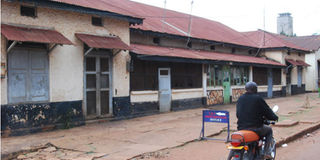Jinja leaders, locals divided over demolition of 100 old buildings

Some of the old structures of Asian architecture in Jinja City. Some of the structures are being disputed in court. PHOTO/PHILIP WAFULA
What you need to know:
- Authorities note that the city has a huge bearing on the Asian community and thus the old structures should remain part of its history but others contend that they are in a dilapidated state, unfit for a city.
On July 1, Jinja together with Fort Portal, Masaka, Mbale, Gulu, Arua and Mbarara became regional cities.
The transition led to the creation of Jinja City Southern Division, comprising formerly Walukuba-Masese Division, Mpumudde-Kimaka Division and Jinja Central Division; and Jinja City North Division, comprising formerly Mafubira Sub-county, Bugembe Town Council and Budondo Sub-county.
However, despite the milestone, there are more than 100 old units of Asian architecture in the city which have divided some leaders and residents with some calling for their demolition while others want them preserved for posterity.
Mr Moses Bizitu, the Jinja Municipality speaker, says such buildings would have been demolished to pave way for a proper urban setting, but their ownership is being contested in court.
“We could have done a clean up of such buildings, but even if they were not in court, there is a law that mandates us to attach property because of accumulated arrears,” Mr Bizitu says.
“When you demolish a building, you retain the land and reallocate it; we have such powers but only when there is no matter in court. For now, we can’t do anything,” he adds.
Mr Bizitu says most buildings are corroded and being occupied rent-free because they lack water and functional drainage systems. The buildings were placed under the Departed Asians Property Custodian Board (DAPCB), an auxiliary institution of the Ministry of Finance.
Disputed properties
However, the DAPCB has been embroiled in multiple scandals, some relating to 300 Asian properties owned by businessman Praful Chandra Patel.
The Parliamentary sub-committee on Commissions, Statutory Authorities and State Enterprises (Cosase) in July asked Mr Patel to produce documents relating to such properties that appear against his name in the Custodian Board registry.
This was after Mr Patel, in March, told MPs that he had picked repossession certificates for at least 39 of the 50 properties, but could not divulge details regarding the original owners.
Some of the properties are on plots 52 Kira Road, 32 Madhvani Road, 64 Oboja Road and 7 Oboja Road, all in Jinja City.
Although Mr Patel provided the committee with information of some of the plots, MPs were concerned that only one of the five proprietors signed general powers of attorney for all the properties and only cleared Plot 66 Oboja Road.
Mr Muhammad Baswari Kezaala, the deputy ambassador to India and former Jinja mayor, said the DAPCB is central to the demolition since it has over the years been re-allocating repossessed properties to different Ugandans and has been challenged in court.

Deputy ambassador to India Mr Muhammad Kezaala says most Ugandans and Africans now fancy high-rise structures. PHOTO/NMG
“As local authority, it becomes extremely difficult, if not impossible, to identify who to enforce compliance with. That is why I see many dilapidated structures in the Jinja City centre. Let DAPCB be dissolved and Asians asked to sell to locals to develop.
“The DAPCB has no more role to play; it caused the mess 28 years ago and can’t purport to be putting it right. If ownership issues can be sorted, buildings can be reinnovated and painted in bright colours as a tourism attraction. That was our arrangement under this programme,” Mr Baswari says.
Mr Baswari’s administration wanted Iganga Road, Main Street and Gabula Road to be painted in bright colours as a new product on Uganda’s tourism catalogue.
He says Jinja’s evolution has a big bearing on the Indian community; therefore, some of these old structures with Asian architecture should remain part of the city’s history.
“I have been to Hollywood, America’s film industry capital, and noticed that they have maintained 20th century structures and that is a tourism attraction. I have also had an opportunity to see the same arrangement in a number of European cities and Egyptian flat cities,” Mr Baswari says.
“Unfortunately, most Ugandans and Africans now fancy high-rise structures. I found the same experience in China where skyscrapers are being built in total disregard of the old beautiful Chinese architecture, yet you can build a skyscraper with a local and historical mix,” he adds.
Erosion of cultural values
Mr Baswari says if the Asian architecture is demolished, said the cultural values on which Jinja city is anchored will be eroded.
He compares it to introducing a bar at Islamic University in Uganda or a mosque at Uganda Christian University, which would mean that the core values for which the institutions were started has changed and accordingly, they would have to change their names.
“So is the organisational culture of cities; new developments come up to rhyme with changing times, but the original core values have to stay. Our grandchildren will want to know what the original Jinja looked like and we should not deny them such an opportunity,” he says.
Already, there are some buildings in Jinja Town, for example, one near the Post Office, from where a segment from ‘The Last King of Scotland’, a film depicting President Idi Amin, was shot and is expected to give the city some exposure.
Capt David Buyagala, a resident of Mpumudde Village, Mpumudde-Kimaka Division in Jinja Municipality, says the city should maintain its Indian architecture like other urban such as Mombasa in Kenya.
“Mombasa has retained its Indian architecture and Jinja should do the same considering that Asians were the ones who introduced such houses. In some countries, such items are preserved,” Capt Buyagala says.
However, Mr Wanambwa Makabuli, a teacher from Igenge Village, Bugembe Town Council in Jinja District, says there is nothing about Asian architecture to preserve.
“Technology and architectural designs have evolved overtime; so what is there to preserve? And sleeping in a house all walled by asbestos isn’t trendy in the current sweltering conditions. There is nothing we are missing,” he says.
Mr Fred Obura, a tour guide at Source of the Nile, who has lived in Jinja for 40 years, says since Jinja is now a city, he doesn’t think its current status should tolerate such houses.
“Indian houses have a history and although their demolition means an erosion of their legacy and existence, Jinja is now a city and needs better structures,” he said.
Mr Obura adds that some of the houses were constructed in the 1920s and 1930s and their leases have since expired or are soon expiring. While there is a need for development, there are concerns that it should not be at the expense of Asian culture.
Last year, the vice chairman of the Indian Association of Uganda, Mr Sanjit Patel, called for the enactment of a Heritage Act to preserve such houses.
“The country needs development but heritage also needs to be preserved. When someone says Old Kampala, what quickly comes to your mind are the Old Kampala houses. Then, there are Railway Quarter houses that have stood for over seventy years. Should also such history be eroded because of development? I don’t think so,” Mr Patel said.
Some houses rapidly underwent remodelling, demolition or replacement by high-rise structures, with the most recent demolition happening on Naranbhai Road in 2018.
Madhvani Group House on Main Street and other buildings on Iganga Road and Gokhale Street have also been remodelled into a fusion of European and Asian architecture.
While commemorating the African World Heritage Day on May 5 last year, the European Union, with Ugandan partners, launched a photographic book, three annotated maps and a mobile app with content meant to protect the posterity of historical buildings and sites in Kampala, Jinja and Entebbe cities.
The collaboration provides an avenue to share experiences in documentation, protection, rehabilitation and economic opportunities in protection of cultural heritage.
Background
In 1972, President Idi Amin expelled Asians from Uganda, and upon leaving, DAPCB was formed. Some of their properties were put under its custody while other owners left theirs to the Muslim community since they were Indian-Muslims and other properties were given to Muslims by Amin.
Those that had mortgages were placed under the custody of Bank of Uganda, which later paid the mortgages to the different lending institutions. Asians who had no property were flown back to India while majority went to Britain and Canada among other foreign destinations.
In 1982, President Milton Obote formed the Expropriation Act, which allowed Asians to return and repossess properties, and a handful returned. In 1987, Mufti Saad Luwemba relinquished properties that were in the hands of the Uganda Muslim Supreme Council (UMSC) to government and in 1992, a big repossession exercise started, ending before 2000.
Whereas a sizeable number of Asians returned, it is alleged that majority did not, and even some of those who did were relatives, possibly with no proper documentation as real owners were either dead or unable to return.
However, they succeeded in repossessing the properties while for those that were not, African managers of the exercise manoeuvred and got repossession certificates in names of the former owners.





